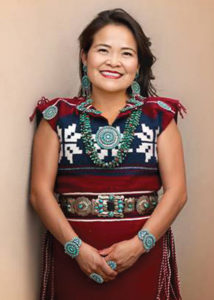Solutions for Food, Energy, and Water Challenges Faced by Indigenous Communities

Presented January 14, 2021
At the University of Arizona, our Indigenous Food, Energy, Water, Security, and Sovereignty program works on solutions to challenges faced by Indigenous communities in a way that involves the community in the co-design of these solutions. The vision of this program is to train graduate students to have intercultural awareness, have an expertise in water and agricultural technologies, secure water and food sovereignty, and contribute to a more diverse workforce. Currently, we have twenty-six trainees and nearly forty percent of them are Native American. The goal of our program is to provide a unique onsite research and training opportunity for our graduate students that bridges engineering, social, and physical sciences. We provide an opportunity to get education in Indigenous governance, culture and society, and with that foundation build up to the basic fundamentals of the discipline that students are pursuing to an interdisciplinary training that allows them to also get the fundamentals in instrumentation and sensors and materials across the food, energy, and water nexus.
Our primary partner is Diné College, the oldest tribal college in the United States, which is on the land of the Navajo Nation, the largest tribe in the United States with the largest land base in the United States, equivalent in size to the state of West Virginia. At Diné College, there’s a land grant office whose mission is to empower the community with knowledge and strengthen them in various skills.
Our research theme is the development of novel and sustainable solutions for off-grid production of safe drinking water, brine management operations, and controlled environment agriculture systems. Approximately nine percent of Indigenous communities across the United States do not have access to adequate clean water supplies or waste disposal systems. On the Navajo Nation, thirty-five percent of people do not have access to clean water because of the widely dispersed homes and the fact that they are not connected to central energy power and water systems. This calls for innovative solutions.
We found that immersion within the Indigenous community was really profound for the students. They spent their spring break in the Navajo community going to the capital of the Navajo Nation and meeting with the Navajo-elected leaders, understanding how a tribal government functions, and learning about tribal sovereignty. They visit with the environmental professionals in the tribe that manage the water and the land. Then the students go to the tribal college and learn how a tribal college system works, meet and interact with tribal college students, and begin to train and do some teaching. Then they go to a community where they stay with a local family in a Hogan, which is a traditional dwelling of the Navajo people. They experience what it means to live without immediate access to food, energy, and water. During that time, they participate in storytelling training from cultural experts and medicine people to help them understand the Navajo worldview. They go into the community and learn about the other challenges such as uranium mining and other legacy mining and how that has impacted people. They learn from elders about gardening.
Many of our graduate students are role models for other Navajo high school students. This is how we’re able to support the pathways of young native students who want to go into higher education. We also provide training for tribal colleges and university. Students from Diné College comes to the University of Arizona and spend about a week attending various intensive workshops. University of Arizona students also go to Diné College for a week and have an opportunity to do food, energy, and water training. These learning modules are available to the tribal college faculty so they can integrate them into other courses.
Our program’s vision is to be sustainable, and sustainability is connected to the long-term development of Navajo technicians and professionals that can contribute to the workforce with the skills to address food, energy, water insecurities in Indigenous communities. We are working to meet the need of a food, energy, and water workforce, and also the need at the tribal, local, state, and international levels—developing a workforce that has intercultural awareness, experience working with Indigenous communities, and trans-disciplinary food, energy, and water skills. It’s important that students know their training is not just applicable for Indigenous communities, but for developing communities around the world.
Ahé’hee!
Published in the Spring 2021 Humanist
